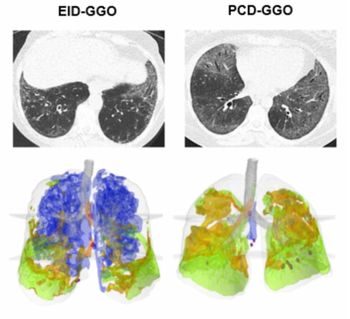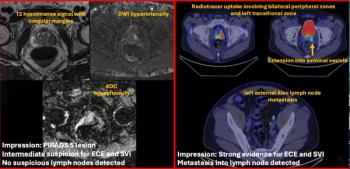
Emerging Research and News in Prostate Cancer Imaging — October 2025
Catch up on the most-well viewed prostate cancer imaging content in October 2025.
New research in prostate cancer (PCa) imaging in October ranged from a new meta-analysis on the PI-RADS v2.1 system for prostate magnetic resonance imaging (MRI) to the use of prostate-specific membrane antigen (PSMA) positron emission tomography (PET) for staging newly diagnosed high-risk PCa, and insights on emerging theranostic agents from a two-part interview with Emmanuel S. Antonarakis, M.D. With this in mind, let’s take a closer look at our PCa imaging content coverage from October.
In the first part of a Diagnostic Imaging interview,
This stage migration could be attributed in part to the aging population, a downturn in prostate-specific antigen (PSA) screening following an adverse recommendation in 2012 from the U.S. Preventive Services Task Force and the clinical adoption of PSMA PET with its increased sensitivity for PCa detection, according to Dr. Antonarakis, a Clark Endowed Professor of Medicine and director of genitourinary oncology with the Masonic Cancer Center at the University of Minnesota.1
Can PSMA PET Enhance Staging for High-Risk PCa?
In a prospective study comparing 18F-PSMA-1007 PET/CT to initial 18F-NaF PET/CT in 160 patients with newly diagnosed high-risk PCa, researchers demonstrated that
Overall, 18F-PSMA-1007 PET/CT increased metastatic detection by 15 percent compared to initial staging with 18F-NaF PET/CT. This enhanced staging accuracy prompted treatment plan changes for 21 patients in the cohort, including 19 patients with advanced PCa.2,3
A Closer Look at a New Meta-Analysis on PI-RADS v2.1 for Prostate MRI
In order to assess the utility of the PI-RADS v2.1 system for detection of clinically significant PCa (csPCa) on prostate MRI, researchers recently conducted a
Patient-level sensitivity was 96 percent for PI-RADS category > 3 assessments and 88 percent for PI-RADS category > 4 assessments. The system also effectively correlates lesion category with cancer detection rates (CDRs), which ranged from 3 percent in PI-RADS 1 to 83 percent in PI-RADS 5, according to the meta-analysis authors.4,5
However, the meta-analysis highlighted concerns regarding the quality of evidence, noting that 29 percent of the included studies showed a high risk of bias or issues with applicability. Studies with high bias risk displayed reduced lesion-level sensitivity and increased cancer detection rates (CDRs) for lower PI-RADS categories compared to low-bias studies, emphasizing the need for rigorous study design in future evaluations.4,5
What Recent Research from the ESMO Conference Revealed About Pluvicto and Metastatic Hormone-Sensitive Prostate Cancer
The phase III PSMAddition trial evaluated Pluvicto (Lu-PSMA-617) combined with standard of care (SoC: ARPI and ADT) in treatment-naïve mHSPC patients. In results presented at the European Society for Medical Oncology (ESMO) conferenced, researchers demonstrated that the
Preliminary findings from the study also noted a 16 percent improvement in overall survival rates. While the Pluvicto/SoC arm showed a higher percentage of grade 3 adverse events (50.7 percent vs. 43 percent with SoC), the most common all-grade adverse events were generally low-grade effects, including dry mouth, nausea, fatigue, and anemia.6-8
What Does the Future Hold for Theranostic Agents?
In the theranostic landscape, radioligand agents targeting PSMA are showing promise in both advanced and earlier disease settings.
In patients with metastatic castration-resistant prostate cancer (mCRPC), the radioligand agent 177Lu-PSMA-I&T, which is currently in a phase 3 clinical trial, may offer a viable alternative prior to chemotherapy, noted Dr. Antonarakis in
Beyond established PSMA agents,
Researchers are also exploring non-PSMA cell surface targets highly expressed in PCa for future imaging, including STEAP1, B7-H3, and TROP2, according to Dr. Antonarakis.9
References
1. Hall J. Current perspectives on prostate cancer and emerging theranostic agents, part 1. Diagn Imaging. Available at:
2. Madsen C, Zacho HD, Fuglo D, et al. 18F-PSMA PET/CT versus 18F-NaF PET/CT for staging and treating newly diagnosed high-risk prostate cancer: a prospective single-center study. J Nucl Med. 2025 Oct 9:jnumed.125.270822. doi: 10.2967/jnumed.125.270822. Online ahead of print.
3. Hall J. Study: PSMA PET/CT leads to metastatic staging changes in 25 percent of patients with newly diagnosed high-risk PCa. Diagn Imaging. Available at:
4. Nedelcu A, Oerther B, Benkendorff A, et al. PI-RADS version 2.1 for prostate MRI interpretation: associations of study quality and cancer detection metrics—a systematic review and meta-analysis. AJR Am J Roentgenol. 2025 Oct 15. Doi: 10.2214/AJR.25.33583. Online ahead of print.
5. Hall J. What a new meta-analysis reveals about the PI-RADS v2.1 system for prostate MRI. Diagn Imaging. Available at:
6. Tagawa ST, Sartor O, Piulats JM, et al. Phase III trial of (177Lu)Lu-PSMA-617 combined with ADT + ARPI in patients with PSMA-positive metastatic hormone-sensitive prostate cancer (PSMAddition). Presented at the European Society for Medical Oncology (ESMO) Congress 2025, Oct.17-21, 2025, Berlin, Germany. Available at:
7. Novartis. PSMAddition data show Novartis Pluvicto delays progression to end-stage prostate cancer. Available at: https://www.novartis.com/us-en/news/media-releases/psmaddition-data-show-novartis-pluvictotm-delays-progression-end-stage-prostate-cancer. Published October 19, 2025. Accessed October 20, 2025.
8. Hall J. New PSMA PET research shows merits of Pluvicto in metastatic hormone-sensitive prostate cancer. Diagn Imaging. Available at:
9. Hall J. Current perspectives on prostate cancer and emerging theranostic agents, part 2. Diagn Imaging. Available at:
(Editor’s note: This article was written with artificial intelligence and reviewed by human editors for accuracy.)
Newsletter
Stay at the forefront of radiology with the Diagnostic Imaging newsletter, delivering the latest news, clinical insights, and imaging advancements for today’s radiologists.




























